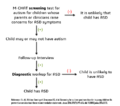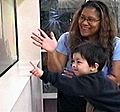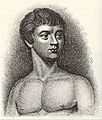Autism spectrum facts for kids
The autism spectrum describes a natural variation in how people's brains work. It's not a sickness, but a different way of thinking, learning, and interacting with the world. People on the autism spectrum are often called autistic. This spectrum includes conditions like autism and Asperger syndrome.
Contents
Understanding the Autism Spectrum
The word "spectrum" is important. Think of a rainbow, where colors blend into each other. The autism spectrum is similar. It means that every autistic person is unique. They have different strengths and different challenges. Some people might need a lot of support, while others might need very little.
What Does Being Autistic Mean?
Being autistic means a person's brain processes information differently. This can affect how they:
- Communicate: They might use words differently or prefer non-verbal ways to express themselves.
- Interact socially: They might find social rules confusing or prefer quiet activities over large groups.
- Experience senses: Sounds, lights, tastes, or textures might feel much stronger or weaker to them.
- Think: They might have very focused interests or prefer routines and predictability.
Common Traits of Autistic People
Many autistic people share some common traits, but how these appear varies greatly.
- Social communication differences: This can include difficulty understanding body language or facial expressions. They might also find it hard to start or keep a conversation going.
- Repetitive behaviors and routines: Autistic people often find comfort in routines. They might also have repetitive movements, like hand flapping, which can help them manage their feelings.
- Special interests: Many autistic people have very strong, focused interests. They can become experts in these areas, like dinosaurs, trains, or specific video games.
- Sensory sensitivities: Bright lights, loud noises, or certain textures can be overwhelming or even painful. Others might seek out certain sensory inputs.
Living on the Spectrum
Being autistic is a part of who someone is. It's a different way of experiencing the world. Many autistic people are very creative, logical, and have unique perspectives. They can be very honest and loyal friends.
Diagnosis and Support
A diagnosis of autism spectrum disorder (ASD) is made by doctors or specialists. They look at a person's development and behaviors. Getting a diagnosis can help people understand themselves better. It can also help them get the right support. This support might include learning new ways to communicate or managing sensory challenges.
Neurodiversity
The idea of neurodiversity suggests that different brain types are natural variations. Just like there are different hair colors or heights, there are different ways brains can be wired. Autism is seen as one form of neurodiversity. This idea promotes acceptance and understanding of all brain types.
Related pages
Images for kids
-
Portrait of Victor of Aveyron, a feral child caught in 1798 who displayed possible symptoms of autism
-
Leo Kanner introduced the label early infantile autism in 1943.
-
Donna Williams, one of several memoirists who have introduced the general public to a more nuanced, emic portrayal of life on the spectrum
See also
 In Spanish: Trastornos del espectro autista para niños
In Spanish: Trastornos del espectro autista para niños








